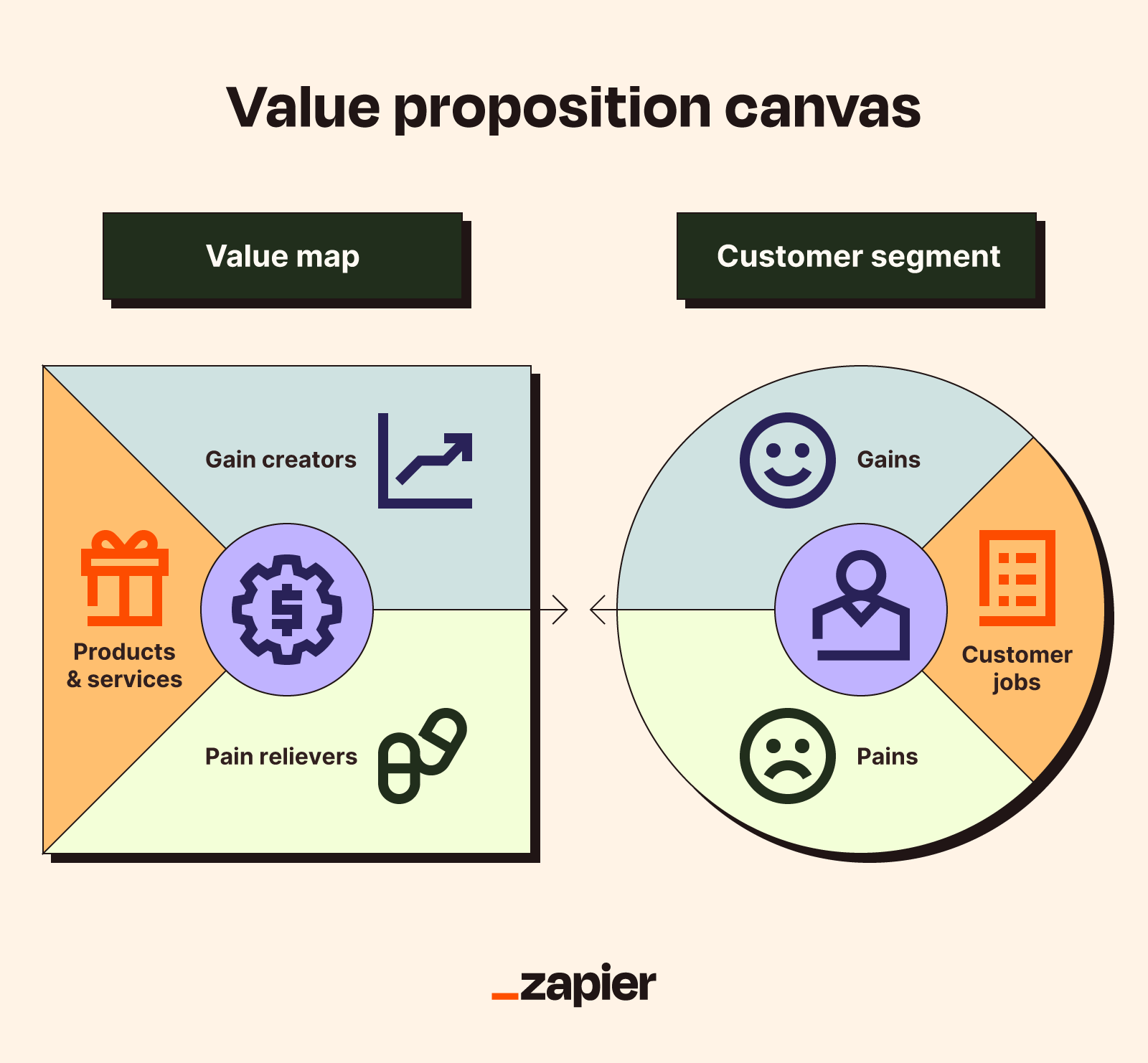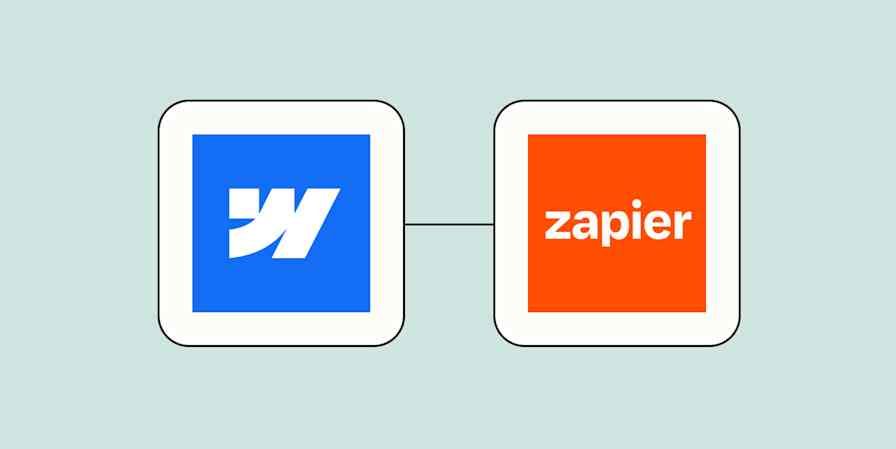My nephew has recently hit the delightful developmental stage where his response to anything you say is "Why?" It's like being on a game show where every answer you give is met with another question, and the grand prize is needing to lie down.
"Why is this rock round?" he recently asked, eyes wide with genuine curiosity.
"Because...erosion?" I ventured. (There's a reason why I'm a marketer and not a geologist.)
"Why erosion?"
And so began a philosophical ping-pong match that left me questioning the very fabric of reality and my nephew with a newfound appreciation for the Grand Canyon. This endless loop of curiosity is how businesses should approach using a value proposition template. Like a four-year-old's relentless questioning, businesses should keep asking "Why?" to uncover the real reasons people buy their products.
In this post, I'll break down the ins and outs of value propositions, provide you with a variety of business value proposition templates, and show you real-world examples of companies that are nailing it. You'll walk away with a clear understanding of value props and how to craft the perfect one for your unique business.
Table of contents:
What is a value proposition?
A value proposition is a simple message that describes the benefit your product or service offers customers.
It's a promise to customers—a clear, simple message outlining the benefits of your product or service and why they should choose you over your competitors. It's your secret sauce, the reason your offering is special and appealing.
Crafting your value proposition before launch ensures you meet customer needs and market demands. It forms the foundation of your marketing, connecting your business plan to your target audience.
A compelling value proposition will tell you:
Who the target audience is
Their biggest need or challenge
The benefit or value offered to them
What makes the offering different or better than competitors
12 unique value proposition templates
I've compiled some business value proposition templates, inspired by widely-used formulas, to help you get started. Included are common use cases for each example, but these frameworks are adaptable enough for any industry.
1. Classic benefit-oriented

Though simplistic, this value proposition statement template works for a reason. It gives your target customers an easy-to-digest reason why they need your product or service in their lives. Just remember, undersell and overdeliver for the best results. Savvy customers can smell empty promises from a mile away.
"For [target customer] who [need/want], our [product/service] is a [product category] that [statement of benefit]."
Use cases: Consumer electronics, automotive, household appliances, and other industries that benefit from clearly articulating the specific advantages of their products
2. Addressing a pain point

Coming up with a product that solves a problem is the hard part. Creating a value proposition for it should be like shooting fish in a barrel. Except shooting at a barrel full of captive fish seems overcomplicated and messy. Let's just say creating your value prop should be easier than picking up a fish flopping on the ground after you dumped it out of a barrel.
Addressing a pain point in your value prop helps potential customers quickly understand how your product can improve their lives. Be specific about who benefits and what problem is solved. If you can articulate your audience's aggravation and demonstrate how to assuage it, you'll have customers lining up to hand over their cash.
"We help [target audience] [solve a specific pain point] by [product feature or benefit]."
Use cases: Health care, IT services, home improvement, and other industries that often deal with specific issues or challenges that their products or services are designed to address
3. Outcome-based

An outcome-based value proposition framework focuses on the end result your customers desire. It's all about helping them achieve their sought-after objectives through your one-of-a-kind method.
To craft an effective outcome-based value proposition:
Identify your target audience's biggest challenge.
Determine the end result they want to achieve.
Figure out how your product or service enables them to achieve that outcome.
Combine these elements into a concise statement following this formula:
"We help [target audience] achieve [desired outcome] through our [unique approach]."
Use cases: Education, professional training, fitness, and other industries that focus on helping the target audience achieve specific results
4. Emotional appeal

With an emotional appeal value proposition, you're selling an experience and a feeling, not a specific feature or benefit. This type of value proposition template aims to motivate customers in a deeply personal way. But use sparingly, as constant emotional manipulation can seem, well, manipulative.
"Experience [emotive benefit] with our [product/service], designed for [target audience]."
Use cases: Beauty and wellness, travel and hospitality, entertainment, and other industries that thrive on creating emotional connections and experiences
5. Convenience-driven

The convenience-driven value proposition taps into the desire for simplicity and efficiency. Consumers are drawn to products or services that reduce cognitive load and simplify their lives. This strategy is like me trying to fix something—I simplify the task by calling a professional.
"We make [task or goal] easier and more efficient for [target audience] through [specific feature or benefit]."
Use cases: Fast-moving consumer goods, eCommerce, on-demand services, and other industries that thrive on providing quick and easy solutions to daily needs
6. Exclusivity appeal

We all want what we can't have, right? This value prop template plays on the psychological principles of scarcity and social status. Exclusivity triggers a sense of belonging to an elite group, which can be a powerful motivator. It also creates a perception of higher value, making the product or service more desirable.
"Join a select group of [target audience] who enjoy [exclusive feature or benefit] with our [product/service]."
Use cases: Luxury goods, high-end fashion, premium services, and other industries with consumers seeking unique, high-status products
7. Expert endorsement

In a world where everyone's an armchair expert, this value proposition brings in the big guns to build trust and confidence in a product or service.
When an expert or industry leader recommends your product, it acts as a stamp of approval for your target customers. It's social proof that your solution is the real deal, giving you a competitive edge that's hard to beat.
As a value proposition, expert endorsements hold a lot of weight with your target customers—whether it's a top chef who swears by a kitchen knife, a fitness guru raving about a protein shake, or your aunt's '90s crush slinging a butter substitute.
"[Expert or authority in field] recommends our [product/service] for [specific benefit or solution]."
Use cases: Health care, fitness, finance, technology, and other industries where expert validation can significantly influence purchasing decisions
8. Testimonial-based

A testimonial-based value proposition showcases the experiences of existing users to build credibility and humanize your brand. It's peer pressure put to good use.
The inclusion of a specific number of users adds to its authenticity, making it especially powerful in markets where personal experiences and customer testimonials are highly valued.
"See why [number] [target audience] trust our [product/service] for [specific problem or goal]."
Use cases: Travel and hospitality, home services, personal care, and other industries that impact personal or professional life considerably
9. Aspirational message

This proposition framework aims to inspire and motivate your target audience by aligning your product or service with their self-improvement goals. It's like a motivational poster but with fewer dangling kittens.
An aspirational message value prop works by tapping into the audience's desire to be a better version of themselves, or at least look like it on Instagram.
"Elevate your [aspect of life or business] to the next level with our [product/service]."
Use cases: Lifestyle, personal development, luxury brands, and other industries that appeal to customers' desires for self-improvement and status
10. Cost-efficiency emphasis

Focused on practicality, this value proposition appeals to your audience's rational side by highlighting the economic benefits of a product or service. It appeals to budget-conscious consumers and those looking to maximize value.
A cost-efficiency framework emphasizes how much time, money, or resources a customer can save by using your product or service. This strategy is widely used in competitive markets where price and value are significant deciding factors.
The key is to quantify potential savings to grab attention. A strong cost-efficiency value proposition convinces target customers that your offering is a smart investment by using a tangible value.
"Save [time/money/resources] and achieve [solution/goal] with our [product/service]."
Use cases: Retail, consumer electronics, utility services, and other industries where consumers are particularly price-sensitive
11. Innovation highlight

As someone who suffers from shiny object syndrome (I've been glued to some version of an iPhone since they dropped in 2007), I'm a total sucker for the innovation highlight value proposition.
This strategy is all about showcasing those cool, innovative features that make life easier, better, or just way more fun (like no longer having to use T9 to text). It appeals to the consumer's curiosity and desire to be part of something new and revolutionary. It can create excitement and anticipation, which are strong motivators for those early adopters and tech enthusiasts who camp outside stores for the latest gadget.
"We feature [technology/innovation] that [solution or benefit] for [target audience]."
Use cases: Technology, automotive, renewable energy, pharmaceuticals, and other industries where innovation and cutting-edge developments are key differentiators
12. Risk reduction

By focusing on reducing potential risks, this value proposition appeals to the type of people who only buy non-habit-forming multivitamins and other risk-averse consumers. This approach reassures the audience by highlighting safety, reliability, and security features, thereby reducing the perceived risk associated with the purchase or use of the product or service.
"With our [product/service], reduce the risk of [specific problem or issue] in [specific scenario]."
Use cases: Finance, health care, insurance, cybersecurity, legal services, and other industries where the cost of error is high
How to write a value proposition
Crafting an irresistible value proposition is key to standing out from the competition and attracting your ideal customers. If you can't articulate what makes you special, you might as well start rehearsing your pitch for when you have to beg friends and family for their pity purchases.
Your value proposition is what links your business plan to your target market segment. It's often the foundation for all marketing efforts because it helps ensure you're building the right product for the right customers.
Following the four steps below, you'll be able to hammer out your value prop in no time.
Step 1: Identify your target customers
To write a stellar value proposition, you first need to figure out who you actually want to buy from you. Get specific about the types of people or businesses that would benefit most from your product or service. Don't be afraid to exclude people. If you try to please everyone, you'll end up pleasing no one.
Ask yourself questions like:
Who needs what you're selling?
What keeps them up at night?
How can you make their lives easier or better?
What do they value?
How do you stack up against the competition?
Once you've pinpointed your target audience, dig deep into their specific needs and desires. You can do this with market research, focus groups, or some light LinkedIn stalking. Learn what they care about most and what will motivate them to buy from you.
The better you understand your target customers, the easier it will be to create a value prop that speaks directly to them.
Step 2: Define your benefits
A value proposition tells your customers why they should buy from you. To craft an effective one, you need to define your benefits.
Think of your value prop like the old "sell me this pen" challenge. Instead of droning on about features like ink viscosity or ergonomic grip (yawn), you'd emphasize the pen's benefits, like how owning it will make your customer feel like the kind of person who always knows where the nearest post office is. It's about shifting the spotlight from the pen's specs to the adventures it can scribble into existence.
That said, in order to know your benefits, you have to know your features. List out all your product or service's features. Then, write out one or more benefits next to each feature. From there, you should be able to find and prioritize the most relevant benefits to your target customer.
Step 3: Differentiate yourself
Once you've defined your benefits, you need to give customers a reason to choose you over the other guys. It's not necessarily about being better—it's about being different in a way your target audience values.
What makes you unique in your industry or market? Vague claims like "high-quality products at reasonable prices" won't cut it. No one is hoping to buy low-quality garbage for an exorbitant price. That's like going to a restaurant where they brag about their food not poisoning you.
Need help coming up with a key differentiator? Start by going over the features and benefits you documented in the previous step. Note the ones that are unique to your company.
Additionally, one of these common competitive advantages may apply:
Longer-lasting products
Exceptional customer service
Convenience
Special ingredient or attribute
Best-selling product
Expertise
Highest-rated
Ethical
Environmentally friendly
Hassle-free
Experience
Customizable product
Same-day service
Step 4: Communicate your value
The final step is to put it all together in a simple statement that taps into your customers' wants and highlights your competitive advantage.
Speak their language: Because your value prop is the foundation for all your marketing, you'll want to communicate in a way that resonates with your audience. This might involve using specific words, tone, or style that appeals to them. Echo those words and phrases in your messaging.
Keep it snappy: Aim for two to three sentences, max.
Communicate your benefit: I know I sound like a broken record, but this part is just that important. Focus on the outcomes and advantages for customers, not just what you do or offer.
Be bold yet believable: This isn't the time for modesty, but don't overpromise with exaggerated benefits. Stick to plausible perks to avoid disappointed customers calling your bluff.
Test and refine: A/B test your value proposition and gather feedback. The best value propositions continually evolve based on feedback and market trends.
Crafting your value proposition may be one of the most important things you do for your business. It's about connecting with your target audience, understanding their desires, and maybe convincing them that they need your hand-knitted toilet seat covers more than they need to pay rent this month.
10 examples of value propositions
This list peels back the curtain on the value propositions of well-known companies. It's worth mentioning, however, that businesses usually keep their value proposition close to their chest.
Some of these examples are pieced together from what's publicly available and might not be the word-for-word gospel straight from the company's playbook. But it's a solid snapshot of the value these companies offer to their target customers.
Slack: "Slack is a new way to communicate with your team. It's faster, better organized, and more secure than email."
Domino's Pizza: "Fresh, hot pizza delivered to your door in 30 minutes or less—or it's free."
Zoom: "Connect with anyone, anywhere, on any device with Zoom's reliable video conferencing platform."
Dropbox: "Safely store and share your files from multiple devices with Dropbox, the secure cloud storage solution."
Zappos: "The world's largest shoe store delivered to your door with free shipping and returns."
Tinder: "With 55 billion matches to date, Tinder is the world's most popular dating app, making it the place to meet new people."
Airtable: "Airtable is a low-code platform to build next-gen apps. Move beyond rigid tools, operationalize your critical data, and reimagine workflows with AI."
M&M's: "The milk chocolate melts in your mouth, not in your hand."
Disney theme parks: "Creating magical experiences for guests of all ages through immersive storytelling and high-quality execution."
Zapier: "AI workflow orchestration for everyone. Zapier automates your business's work across 7,000+ app integrations, so you can focus on what matters."
These companies have crafted value propositions that pack a punch in their own way, but they all effectively summarize why their offering is valuable. They provide a clear reason for target audiences to choose them over the competition, paving the way for brand loyalty and success.
You'll notice, too, that none of these examples feel generic. As Chris Bajda, an eCommerce entrepreneur and managing partner of GroomsDay, points out, "If your value proposition could apply to a dozen other companies, it's not strong enough. Generic statements like 'high-quality products at great prices' don't tell customers why they should choose you."
What is not a value proposition?

Marketing is packed with terms that sound similar but mean different things. Value propositions are no exception, often getting mixed up with a few close cousins. Let's break down the key differences between them.
Value proposition vs. positioning statement
Unlike a value proposition, which is customer-focused, a positioning statement outlines your brand's position in the market and how your product is different from alternatives.
A positioning statement is an internal tool used to guide your marketing and business decisions. It's broader in scope than a value proposition and is often written in this format:
For [target audience] who [target audience need], our [product or service name] is a [product or service category] that [statement of differentiating benefit]. Unlike [competitors], our [product or service name] [statement of primary differentiation].
Value proposition example | Positioning statement example |
|---|---|
"We offer high-energy group fitness classes led by certified instructors in a supportive community environment, so you can achieve your fitness goals and feel your best." | "For busy working professionals in the city who want to stay fit with minimal time commitment, our high-intensity interval training gym is a fitness studio that provides efficient and effective full-body workouts in 30 minutes. Unlike traditional gyms, we use heart rate technology and experienced trainers to maximize calorie burn and fitness gains in minimal time." |
A great value proposition is more than simply a positioning statement—it serves as the foundation for a brand that people trust and remember.
Rob Gold, VP of marketing communications at Intermedia
Value proposition vs. mission statement
While a value proposition tells people why they should care about your product, a mission statement defines your company's values and primary goals. It's more about you than the customer.
A mission statement outlines your company's purpose and vision. It captures your fundamental reason for being and guides strategic decision-making. It should drive your value prop, not the other way around.
Value proposition example | Mission statement example |
|---|---|
"We provide the local community with premium, organic, fair-trade coffee and a welcoming space to connect, creating an experience that fosters well-being and connection." | "Our mission is to source and serve the highest-quality organic coffee, foster community, and inspire connection. We aim to be the hub of well-being and social interaction in our neighborhood." |
Value proposition vs. USP
A unique selling proposition (USP) is what distinguishes you from competitors. It highlights what's unique about your product or service to give you a competitive edge. Though related, it's not exactly the same as a value proposition. It's like what the nice lady at Sephora explained to me about eyebrows—they're sisters, not twins.
USP examples include:
Trader Joe's sells high-quality, grid-worthy groceries at affordable prices.
Peloton offers studio-quality spin classes from home.
UGG boots allow you to walk comfortably without socks (a crime).
A USP is about a unique feature, while a value proposition is about the overall value to customers. The USP sets your product apart in the market, and the value proposition shows the benefits of using it. It's the difference between "Here's why we're awesome" and "Here's why you'll love that we're awesome."
Value proposition example | Unique selling proposition (USP) example |
|---|---|
"We help busy professionals on a budget save money without sacrificing flavor through personalized meal plans." | "Our meal planning app optimizes grocery lists, reduces food waste, and delivers delicious, budget-friendly recipes." |
Value proposition vs. slogan or tagline
Your value proposition is the meat and potatoes of your offering, but where do slogans and taglines fit in?
A slogan is a memorable phrase used for brand reinforcement, often tied to a specific campaign or initiative.
A tagline is a more enduring, overarching phrase that encapsulates the brand's essence or promise.
While often used interchangeably, taglines tend to be more permanent and represent the brand identity, whereas slogans are more fluid and campaign-specific.
While slogans and taglines are great for creating brand recognition and getting jingles stuck in your head (looking at you, Burger King), they don't tell you much about what the product actually does for you. A value proposition breaks down how your product solves problems and gives you real benefits. Basically, it's the thing that actually helps customers get why they should choose you.
Some popular slogan and tagline examples include:
Nike: "Just Do It."
McDonald's: "I'm Lovin' It."
Apple: "Think Different."
Value proposition example | Slogan or tagline |
|---|---|
"With 55 billion matches to date, we are the world's most popular dating app, making it the place to meet new people." | "It starts with a swipe." |
Value proposition vs. competitive advantage
Your competitive advantage is the thing that makes your business the one customers just can't ignore. It's what you do better, faster, or smarter than everyone else. Maybe you have proprietary technology, an exclusive supplier deal, or you've just cracked the code on making your product ridiculously easy to use. Whatever it is, it's the thing that gives you an obvious edge.
Your value proposition, on the other hand, is how you translate that edge into something your customers actually care about. It's not just the "why" behind your advantage—it's how it makes their lives better. Think of it like this: your competitive advantage is the secret ingredient, but your value proposition is the way you plate it up and serve it to hungry customers.
Value proposition example | Competitive advantage |
|---|---|
"Our eco-friendly cleaning service uses non-toxic products and sustainable practices, ensuring a healthy and safe environment for homes and businesses." | "Exclusive partnership with local, certified organic cleaning product suppliers, ensuring consistent quality and environmental responsibility." |
Value proposition canvas

Popularized by Strategyzer, a value proposition canvas is a visual framework that helps you create a strong value proposition for your product or service. It's a simple way to make sure you're selling what your customers actually want to buy. Let's break down its components:
Customer segment: This part of the canvas helps you understand what your customers are trying to do and their pains and gains:
Customer jobs: What's your customer trying to get done? Are they trying to impress their boss, save time, or just not cry after a haircut? This covers everything from practical stuff to emotional needs.
Pains: What makes them want to pull their hair out while trying to perform these jobs? Is it slow internet, bad coffee, or existential dread?
Gains: What outcomes and benefits does the customer want to achieve? Are they looking for convenience, bragging rights, or just a good night's sleep?
Value map: This section is where you match what you offer to what your customer needs by relieving pain or creating gains:
Products and services: What are you offering? These are the products and services that help your customers complete jobs.
Pain relievers: How does your product make the lambs stop screaming? This is where you list how your offerings alleviate customer pains.
Gain creators: How do your products improve the customer's life? Maybe you're making them faster, smarter, or better-looking.
By using a value proposition canvas, you can map out the fit between what you offer and what customers want. Spending the time to align these elements will help set your business up for success. You'll have a product that solves real problems in a way that's truly valuable.
Deliver on your value proposition with automation
Once you've nailed down your value proposition, you can leverage Zapier to automate and streamline many of the manual tasks related to marketing and customer engagement, like posting on social media, sending out email newsletters, and even managing customer inquiries. This frees up more time for you to focus on making your products and services even more awesome. Learn more about how to automate your marketing workflows.
Value proposition template FAQ
How do you write a value proposition?
Start by clearly stating what you offer, who it's for, and why it's valuable. Then refine it to be as concise and compelling as possible.
Think of it like answering an endlessly curious four-year-old. Every time you explain what your product does, imagine them firing back with, "Why?" Keep going deeper until you uncover the real reason people choose you. A strong value proposition isn't just about what you do—it's about why it matters.
How long should a value proposition be?
Keep it short and sweet—two to three sentences, max. It should be clear, direct, and easy to grasp at a glance.
If your value proposition can't survive a rapid-fire round of "Why?" questions without losing your audience, it's too long. The goal is to give just enough information to spark interest before attention starts to wander.
What are the steps to create a unique value proposition?
The steps to create a unique value proposition are:
Identify your audience and their needs.
Define what you offer and why it's valuable.
Highlight what makes you different.
Refine your message to make it clear, compelling, and customer-focused.
Each step is like answering another round of "Why?" questions. Why do people need your product? Why does it solve their problem better than anything else? Why should they care? Keep going until you land on an answer that resonates—one that makes your business impossible to ignore.
Related reading:
This article was originally published in January 2024. The most recent update, with contributions from Jeremy Payton, was in April 2025.









